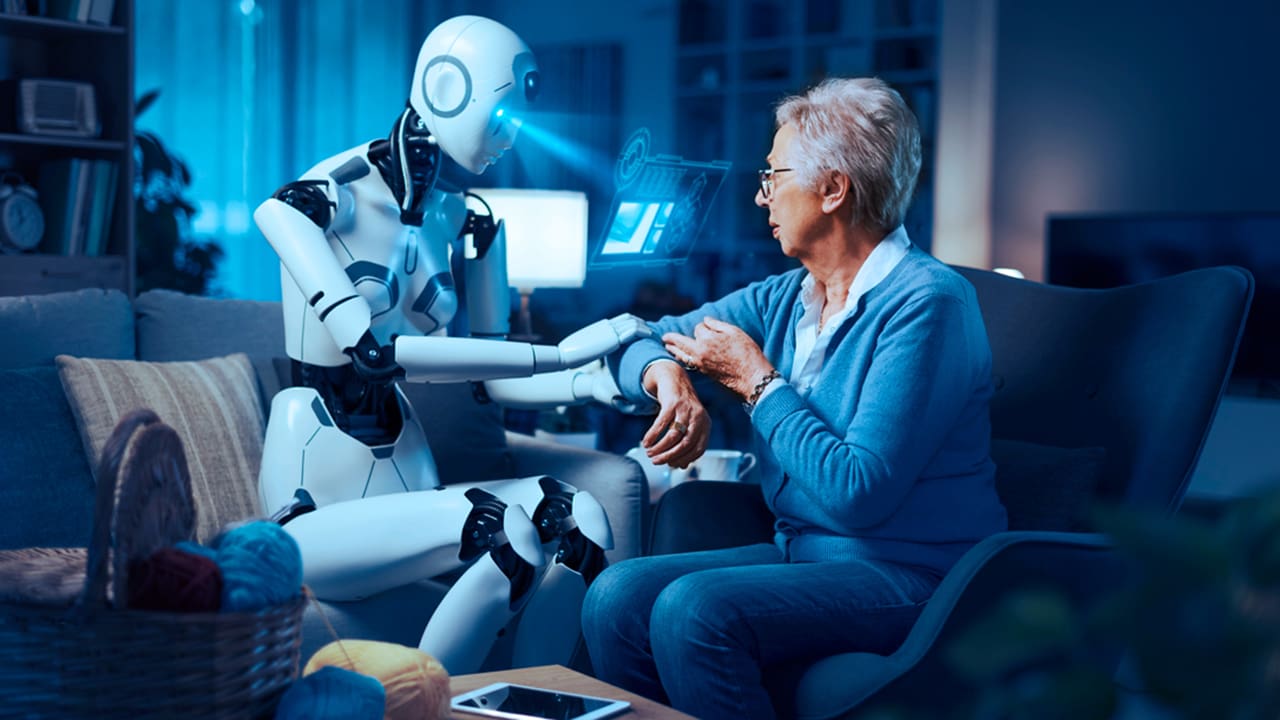Emerging technologies for aiding and caring for the elderly show great promise. Robot home assistants, clinical support robots, wearables, internet of things (IoT) devices, and smart electronics all hold promise as healthcare and quality-of-life tools. However, these tools still have several challenges to overcome.
Growth of An Aging Population
Based on U.S. Census Bureau findings, nonpartisan research organization PRB reports the number of Americans age 65 and older is projected to increase from 58 million in 2022 to 82 million by 2050; a 47% rise. And according to the World Health Organization, the number of people aged 60 and older will hit 2.1 billion by 2050, more than doubling within a span of just 31 years.
Advances in medicine are leading to longer lifespans. However, with aging comes afflictions such as the slowing and/or loss of mobility, reduced vision, loss of hearing, and other issues which can make living at home more challenging. This means many elderly persons require homecare professionals.
Currently, there is a deficit of qualified home health care attendants. Programs like FreedomCare in the United States attempt to close that gap by paying family members or friends of the patient to provide in-home care. However, this program is only available to select groups of people, and it relies on the prospective family member or friend being competent, willing, able to care for the elderly patient. These caregivers are typically not trained healthcare professionals.
How can robotic technology help meet needs in homecare and clinical environments?
Autonomous and remotely supervised robots are being developed, each with their own benefits and challenges.
Neither type of robot is yet able to serve as full-time homecare providers. Some models are beginning to hit the commercial market, but still lack certain critical abilities. Adrian Stoica, PhD, Telepresence Project Chair, IEEE Future Directions, believes autonomous robots are too complex for end users and can do only part of a traditional home care professional’s job. According to Dr. Stoica, what’s missing is sufficient tactile perception, dexterity, and processing power. Robots under remote supervision benefit from a human’s judgment, but are more costly to operate than autonomous robots.
Both types have their advantages. Autonomous robots offer users independence, privacy, entertainment, and social connectivity. Remotely supervised robots under the control of teleoperation dispatchers and supervisors can provide superior responses by way of human intelligence.
So when will robots be ready to serve in the homecare world full-time? Dr. Stoica forecasts it may still be more than a decade before we’ll see standalone autonomous robots in those roles, but remotely supervised robots may be able to do so sooner. For both types, technical standards and regulations will help ensure safety, trust, and security in meeting the unique needs of a diverse aging population.
Clinical Support Robots
Clinical environments offer many opportunities for assistive robotic technology, from therapeutic and rehabilitation applications to aiding those with mental and physical disabilities. In this environment, no singular robot can handle all aging patients’ requirements. Designers of clinical robots must make the human factor a priority for user acceptance and overall utility.
University of Illinois at Urbana-Champaign Professor of Computer Science, Electrical & Computer Engineering, and Mechanical Science & Engineering Kris Hauser cites a very practical use of robots in the clinic. In the initial days of the COVID-19 pandemic, many healthcare professionals contracted the virus due to contact with infected patients. He points out that robots do not contract viruses, and have been used to assist patients during Ebola outbreaks in the past, while helping keep human medical teams safe.
Hauser mentions that functional software used by clinical robots, the clinician’s supervisory software, and the patient’s interface must work together seamlessly and be both easy and intuitive enough for aging patients to understand and use.
Another challenge is teaching robots to perform clinical tasks, such as how to use a stethoscope, oximeter, or blood-pressure meter. If the stethoscope does not receive a pulse in one location on the patient’s body, the robot needs to know to try an alternate location. Also, the robot needs to know how to record and interpret the data received from these instruments.
Another area for development is speech and facial recognition. Clinical robots will need to recognize patients’ faces so as not to administer procedures intended for a different patient. They also need to register a patient’s facial and verbal expression to tell if the patient is in pain, if a doctor needs to be notified, and must be able to identify caregivers to ensure patients are safe from intruders.
Artificial intelligence (AI) scientist and Founder & CEO of Amicus Brain Innovations Dr. Chitra Dorai develops AI-enabled personal advisors for dementia and Alzheimer patients and their caregivers. She believes the human factor is highly critical when creating robotics for elderly care, particularly those with the diagnoses of Alzheimer’s disease.
The robot needs to discern the differences between dementia, Alzheimer’s, and just basic memory loss that comes with age. Dr. Dorai stresses the importance of individual robot designs that fit each patient’s unique needs. This is critical because each of the aforementioned illnesses present many similar symptoms and the numerous diverging points in the illness’s progression.
Objectives for successful future deployment of clinical robots for the aging include considering the human factor when designing robotic assistants for a diverse elder population and designing assistants to support a wide range of functions, settings, applications, and durations. Additionally, designers and healthcare professionals need to determine where autonomous robots or human supervisors must make critical healthcare and safety decisions.
Supporting the Aging with Dignity, Privacy, and Security
Other challenges for robotic medical assistants include teaching them a sense of dignity, companionship, privacy, and security, while ensuring they meet the special needs of the elderly.
For example, many older people are not tech savvy, some are unwilling to learn new technologies, and some cannot physically deal with machines. Current robots are complex and may not be sufficiently adaptive. Robots can also be expensive to purchase or rent and maintain and health insurance may not cover the expenses.
To address these challenges, designers must integrate human emotions and expectations within assistive technologies and be sure to address patients’ specific needs.
Digitally Friendly Communities for the Aging
To enable digital-friendly communities for the aging, technologies must be more efficient for safe and secure data acquisition and analysis. Better interpretational applications are necessary to address current challenges to the validation of sensor-derived patient data.
One of several answers is offered by the IEEE SA Healthcare and Life Sciences Practice. This global platform brings together a broad range of individuals and organizations to evaluate, validate, and develop solutions for establishing trust in new technology applications that will ensure the right to safety, security, and protection of life. The practice focuses on three priorities: clinical health, bio/pharmaceutical value chain, and wellness.
Working with a global community, IEEE SA volunteers are developing standard frameworks for a secure and validated personal patient area network at home and remote and developing solutions for connected wireless medical device data interoperability. IEEE SA volunteers are also exploring frameworks that empower patients with the right to consent when sharing their device data and working on a global standard certification system for wireless connected medical device safety and security. The goal is to establish patient trust and validation through the development of trusted solutions.
For deeper details, four focused webinars are accessible via the links below.
- The Robotic Assistant for the Aging: The Unbalanced Struggle between Benefits and Challenges
- Clinical Support Robots for the Aging: The Human Design Factors, Utility, and Functionality
- Enabling Robotics to Support the Aging with Dignity, Privacy and Security
- Digitally Friendly Communities for the Aging








